Pittsburgh Pirates Offseason: Payroll Flexibility

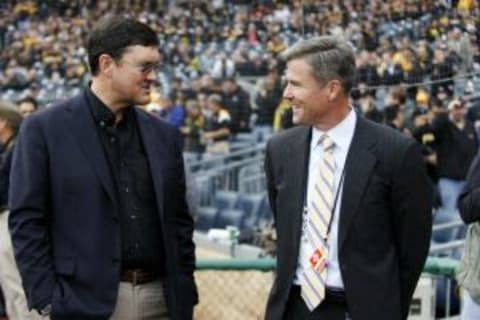
The Pittsburgh Pirates offseason started last Sunday, on the second, after the loss to the Cardinals. The month of October and November are very busy for the 30 clubs, as they all plan to map out the offseason, and look to begin the 2017 season.
The Pirates have already made a move this offseason, acquiring Brady Dragmire, a bullpen depth option in the minors. It is a small move, but a move none the less. The actual landscape of what the team will do depends on the teams finances, and the amount of flexibility Neal Huntington will have to work with. Most of that starts with the arbitration eligible players. Some of these players will get non tendered, but a good portion will be tendered, and the team will likely look to avoid arbitration with all of them that will be tendered. But the overall landscape is easiest to digest position by position.
The team has a pretty set roster for 2017, with just a few needs, but they could very easily be relaying too much on inexperienced players, with two of them having large question marks on defense. For the pre arbitration players, a $25,000 increase will be added to them from their 2016 salaries. League minimum in 2016 was $507,500. This could be a little aggressive, but it is going on the Gregory Polanco change from the $500,000 league minimum in 2014 to the $525,000 he was paid in 2015.
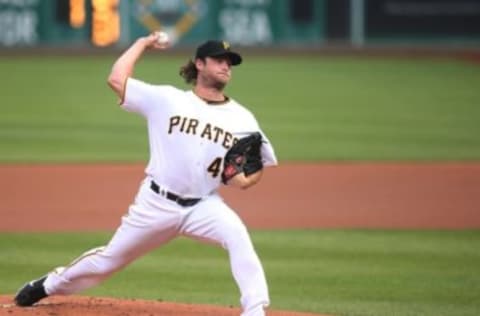
Starting Rotation
The Pittsburgh Pirates starting rotation fell flat on their face. The Pirates finished 22nd in ERA and 18th in FIP. They did not have a single pitcher qualify, as Jeff Locke led the team in innings with 127 and Gerrit Cole had the most innings started with only 116.
After tossing a 3.26 ERA the last three years, 3.38 in 2014 and 2015, Francisco Liriano imploded to a 5.46 ERA. He walked 13.2 percent of the hitters he faced as a Buc, a mark that was 0.5 percent above his previous high. There were some bright spots, however. Jameson Taillon pitched well in his rookie campaign, and Ivan Nova, a free agent, pitched to a 3.06 ERA and a 2.62 FIP. But most of the 2015 rotation is either gone, a free agent, or in the bullpen. As it stands, Cole and Taillon are locks, and Chad Kuhl is basically one as well.
Cole is projected to make $4.2 million according to MLBTR’s predictions. Taillon and Kuhl will come close to league minimum, but given the Polanco’s increase that I’m using as the baseline, that puts Taillon and Kuhl each at $532,500.
The next two in the rotation will be question marks. My money is on Drew Hutchison making the rotation, as he is projected $2.2 million in arbitration. The team just won’t kick him to the curb without giving him a legit shot, and I think he could be a capable back-end starter. At the worst, he will be better than 2015 Jeff Locke in terms of ERA and 2014 Locke in terms of FIP. That leaves a blank spot, which could be filled by Trevor Williams or even Tyler Glasnow, but as we all saw, Glasnow needs some work, and I’d be willing to guess he starts the year in Indianapolis with Williams. With the four pitchers – Cole, Taillon, Kuhl, Hutchison – the Pirates are at $7.465 million.
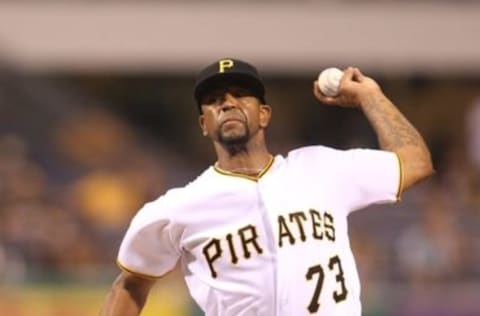
The Bullpen
Neal Huntington builds strong bullpens. Even in 2016, the Pirates pen was strong, although they finished 11th in ERA, they were one non blowup from Antonio Batardo from being number six. We know the pen will be strong, we just don’t know who will be in it.
We can sharpie in Felipe Rivero, who is pre arbitration, Juan Nicasio, projected to make $4.6 million, Tony Watson, a $5.9 million projection, and Antonio Bastardo, who has a guaranteed $6.625 million. Bastardo’s salary does come with relief, as the Mets sent cash considerations, so being aggressive, let’s assume that the Pirates only pay $4.625 million, as the Mets pick up $2 million. That leaves the Pirates with four relievers at a cost of $15.666 million (Rivero is at $541,400. They’ll also probably go with Jared Hughes, projected at $2.5 million, as they kept him all year on the 25 man roster despite having an option over AJ Schugel. The team is now at $18.166 million for relievers.
Schugel could start the season with the Pirates, but I would expect him to be in Indianapolis. Jeff Locke is almost a guarantee to be non tendered as he lost a starting spot, and his $4.2 million projected arbitration is not very valuable to the Pirates. Wade LeBlanc pitched well in Pittsburgh, but he did so in just 12 innings. He has a 4.39 ERA and a 4.67 FIP in his career, and he has been better to right-handed hitters than left-handed hitters in his career. While he could be a nice depth guy, there’s countless amounts of Wade LeBlanc’s available, so his $1.6 million projection is also not very valuable to the Pirates.
With these projections the Pirates pitching is currently at $25,631,400.
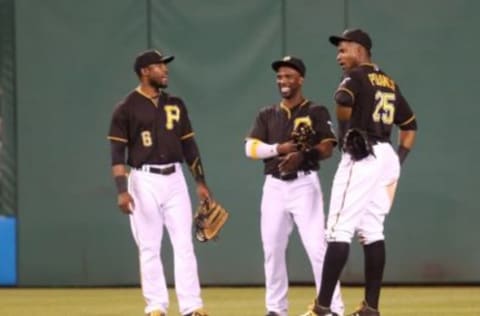
Positional Players
The Pirates starting field is as close to a lock as can be. Francisco Cervelli ($9 million) will be behind the dish, Josh Bell will be at first ($532,500), Josh Harrison ($7.75 million) will be at second, Jung Ho Kang ($2.75 million) at third, and Jordy Mercer, who is arbitration eligible, will be at shortstop. Mercer is projected to make $4 million, an increase of $1.925 million from 2015. Mercer once again left a lot to be desired with the stick, had minimal range. In 2016 Mercer ranked fourth worst in fWAR, in 2015 he was second worst among those with 350 plate appearances, and in 2014 he ranked middle of the pack. An upgrade would be nice, but given the free agent class and the likely options available in trade, Mercer at $4 million is a fine asset for the Pirates, especially if Newman is ready this summer.
The outfield is set, unless the once unthinkable occurs with the start centerfielder. Starling Marte will be in left for $5.333 million, Andrew McCutchen will be in center for $14 million, and Gregory Polanco will be in right for $1.6 million.
The Pirates starting lineup will cost $45.966 million, and combined with the pitching, has the Pirates 25 man payroll at $70.597.
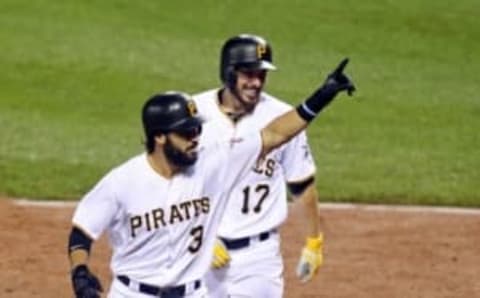
The Bench
The Pirates 2016 bench was excellent. Their pinch hitters did fine, as they ranked eighth, fourth, eighth respectively in average, on-base, and slugging. To start the season, it included Chris Stewart, Mike Morse, Sean Rodriguez, Matt Joyce, and Cole Figueroa.
Morse and Figueroa didn’t provide much, and Morse was designated for assignment on April 13. Figs, on the other hand, was optioned to Indy, later recalled and then optioned back to Indy, before being designated on June 24th.
Sean Rodriguez had a big year, hitting .270/.349/.510 with a 129 wRC+, all being career highs, and 2016 being the first year he had a 100+ wRC+. He also provided solid defense everywhere he played, but he is a free agent. Matt Joyce is a free agent as well, and after hitting .242/.403/.463 with a 137 wRC+, a career high, there might not be a place for him to play, assuming no trades are made. In the outfield, Joyce posted -2 defensive runs saved and a -27.3 UZR/150, which is a worse UZR/150 than McCucthen’s.
As of now, Chris Stewart will be the backup catcher, as he is owed only $1.4 million next year. David Freese, who just signed an extension, will also be back at $6,250,000. John Jaso is working out at third and in the corner outfield positions. He is due to make $4 million, and as a left-handed hitter who could potentially play four different spots and provide insurance for Josh Bell’s potential defense and Jung Ho Kang’s injury history, the Pirates will only get rid of him if the right trade comes up. The last option is utility player Adam Frazier, who is pre arbitration, will likely make be at $532,500.
With Frazier and Bell being able to play the outfield, Jaso learning, and Josh Harrison if need be, the Pirates only real need is a backup shortstop. The bench of the four players is $12,182,500. It puts the Pirates positional players at $57,148,333, and the team’s payroll as a whole at $82,779,733 with these estimates.
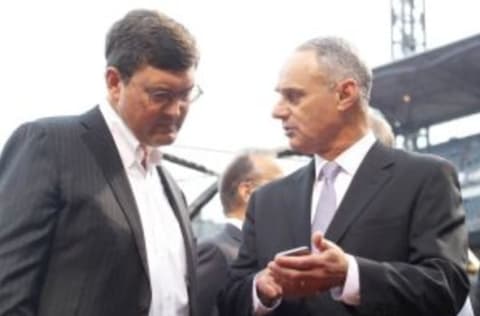
Past Opening Day Payroll’s
The Pirates opening day payroll has gone up every season except for 2009 to 2010, using Cot’s Baseball Contracts. But some of those years are rebuild years, so giving a look at 2010 through now is what is really important. The opening day payrolls for those years are as followed:
- 2010: $39,068,000
- 2011: $42,047,000
- 2012: $51,932,333
- 2013: $66,805,000
- 2014: $71,929,333
- 2015: $90,053,000
- 2016: $99,945,500
The amount of by how much each year is increased is what is important though when going forward. Those differences are:
- 2010-11: $2,979,000
- 2011-12: $9,885,333
- 2012-13: $14,872,667
- 2013-14: $5,124,333
- 2014-15: $18,123,667
- 2015-16: $9,892,500
To avoid skewness, finding the median instead of the mean is important. The median increase since 2010 has been $9,888,916.50. In this case, the mean works as well, and has a value of $10,146,250. What we can expect is about a $10 million increase in opening day payrolls each year, some years less, and some years more, but $10 million is expected. With the Pirates decrease in about 250,000, less should be expected, but at the same time the Liriano deal and increase from national TV, $10 million is still the target.
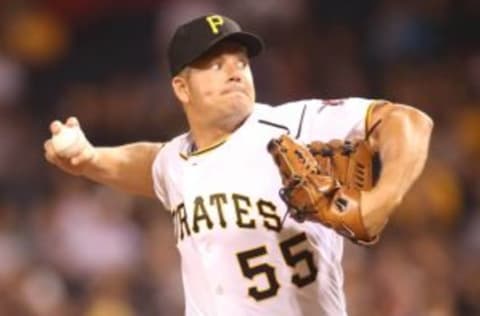
Expectations
The Pirates current payroll, using these projections, is short about $27 million to reach that $10 million increase in opening day payrolls. Expecting them to spend on the lower side is much more reasonable, and they’ll likely spend $23-$29 million this winter. With the four major spots, one starter, two relievers, a backup shortstop, the team should easily fill those holes. They could even tune up more flexibility by trading Jaso away for another utility player in Alen Hanson. They could trade away Josh Harrison, but that leaves second base open. They could even move Tony Watson, a relief pitcher who has been used heavily over the past few seasons to open up a bit more payroll.
Regardless if they make any trades are not, they are still going to be able to sign pieces that fit. With Tyler Glasnow and Nick Kingham waiting, the typical cheap veteran starter will almost be a forgone conclusion to fill out the number five-spot. Ryan Vogelsong could potentially be that guy, or even a Colby Lewis or Edinson Volquez. All three pitchers are far from ideal, but the cheap option would make sense if they can build a super bullpen.
Two spots in the bullpen and a considerable amount of money could allow Neal Huntington to sign solid bullpen arms instead of questionable, high upside ones. Mark Melancon will certainly garner interest from many teams, and Pirates fans, it may not be that far-fetched, but still unlikely. Former friend Joe Blanton would fit in perfectly, even if the team signed Melancon, which once again, don’t bet on it. Despite having a FIP that is 0.72 higher than his ERA in his career, Joe Smith seems to be the ideal Pirate ground ball reliever. They’ll have money to play with for the pen.
The backup shortstop should not be too hard to find. They’ll have the funds to bring back Sean Rodriguez, which would allow for more flexibility. After struggling heavily in 2014 and 2015, in which his BAbip was extremely low at .194 and .201, left handed hitting Stephen Drew is having a nice year. He is making $3 million this year, so a slight raise is likely in order. With his ability to play short and second fairly well, he has the potential to be the teams signing.
Next: Pirates Arbitration Breakdown Juan Nicasio
If the Pirates really wanted to, however, Yunel Escobar could hit free agency. The Angels have a 7 million dollar team option for him in 2017 with a 1 million dollar buy out. Esobar has hit .309/.365/.403 with a 114 wRC+, but he has had a .343 BAbip those two years. In the previous three years, Escobar hit .256/.318/.350 with a wRC+ of 88, as he had a much lower BAbip of .279. If the Pirates buy the bat, he would be an improve over Mercer both offensively and defensively. The one downside, would worse relievers, meaning more high upside arms than established, but the lineup and bench would be stronger.
For this offseason, look for a starter, two relievers, and a bench bat. They’ll likely spend mid-20 million dollar range. I expect the payroll to be about $100 million based on past increases.
*Numbers from fangraphs and salary from baseball-reference